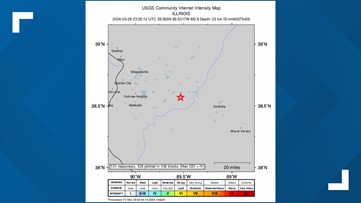The peaceful evening of Thursday in the Metro East area was briefly interrupted by a 2.8 magnitude earthquake near Germantown, Illinois. As residents felt the ground tremble beneath their feet, questions arose about the causes, effects, and broader implications of this seismic event. In this article, we delve into the details of the earthquake, its impact on the community, and the geological factors at play.
Understanding the Earthquake: The United States Geological Survey (USGS) quickly responded to the earthquake, pinpointing its epicenter just north of the intersection of County Road 1000 North and Germantown Road near Germantown. Initial reports indicated that the earthquake occurred at 6:55 p.m. local time, with a depth of approximately 14.2 miles. While the magnitude of 2.8 may seem relatively minor, its effects were felt across the Metro East area, sparking concerns and discussions among residents.
Assessing the Impact: Despite the relatively low magnitude, the earthquake prompted widespread reports of shaking and tremors from residents throughout the region. A USGS map highlighted the areas where residents reported feeling the quake, revealing a broad swath of impact across the Metro East area. Fortunately, there were no official reports of damage or injuries as of Thursday evening, alleviating immediate concerns about property damage or personal safety.
Geological Factors: To understand the occurrence of earthquakes in the region, it is essential to consider the geological factors at play. The St. Louis region sits atop a complex network of fault lines and geological formations, making it susceptible to seismic activity. Additionally, the presence of bedrock in the area allows seismic waves to travel further, amplifying the effects of earthquakes and increasing the likelihood of widespread tremors.
Community Response and Preparedness: In the aftermath of the earthquake, local authorities and emergency responders remained vigilant, monitoring the situation for any signs of aftershocks or additional seismic activity. Community members also took steps to ensure their safety, reviewing earthquake preparedness plans and reinforcing structures as necessary. While the earthquake served as a reminder of the region’s vulnerability to seismic events, it also highlighted the resilience and preparedness of Metro East residents in the face of adversity.
As the Metro East area recovers from the brief disruption caused by the earthquake, attention turns to the future and the potential for similar events. While earthquakes are relatively rare in the region, their occurrence underscores the importance of continued monitoring and preparedness efforts. By staying informed, remaining vigilant, and working together as a community, residents can mitigate the impact of seismic events and ensure the safety and well-being of all.
The 2.8 magnitude earthquake near Germantown serves as a reminder of the unpredictable forces of nature and the importance of readiness in the face of adversity. While the event caused momentary alarm, it also prompted discussions about earthquake preparedness and community resilience. As Metro East residents reflect on the experience, they reaffirm their commitment to safety, unity, and collective action in the face of future challenges.
